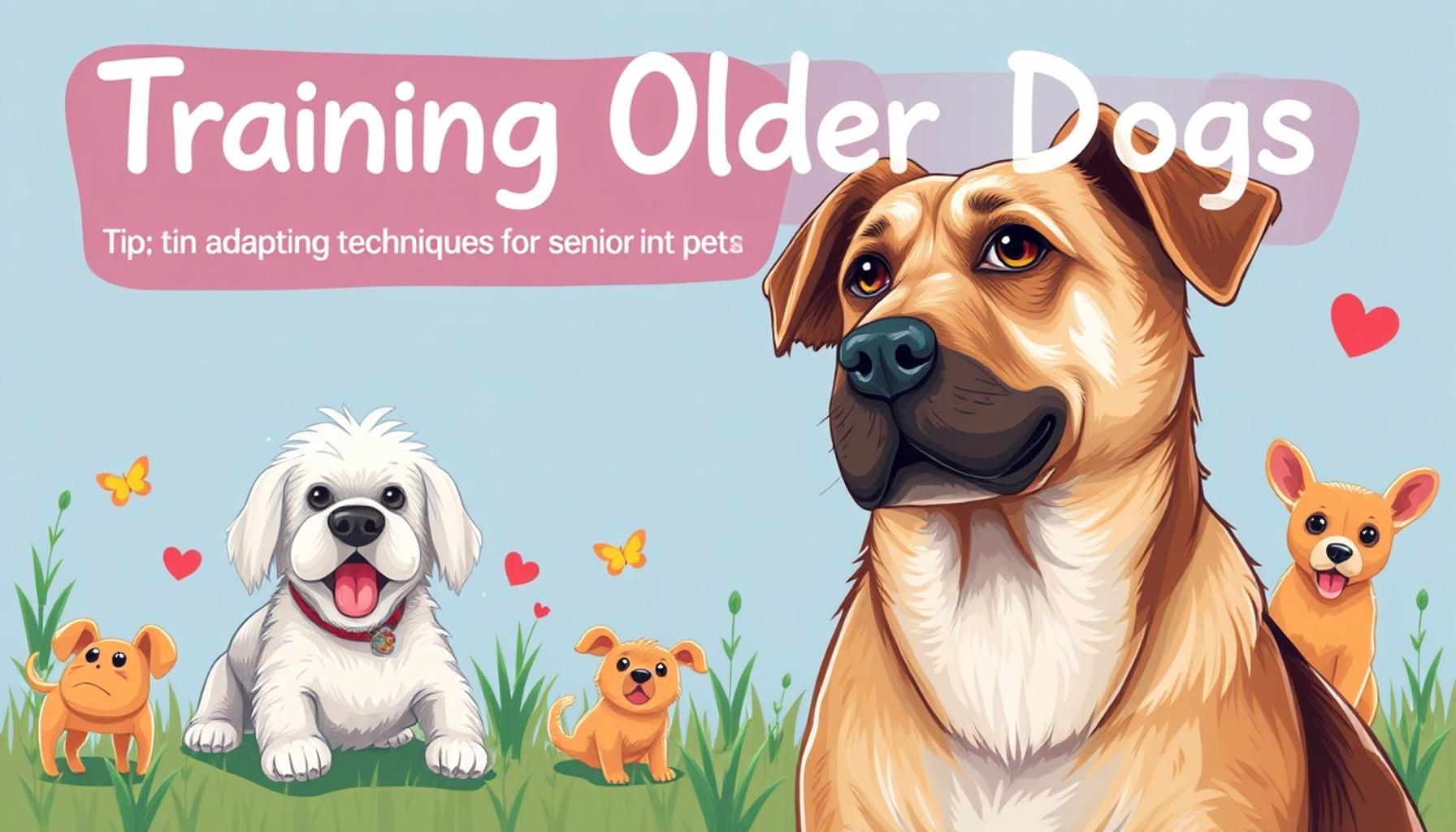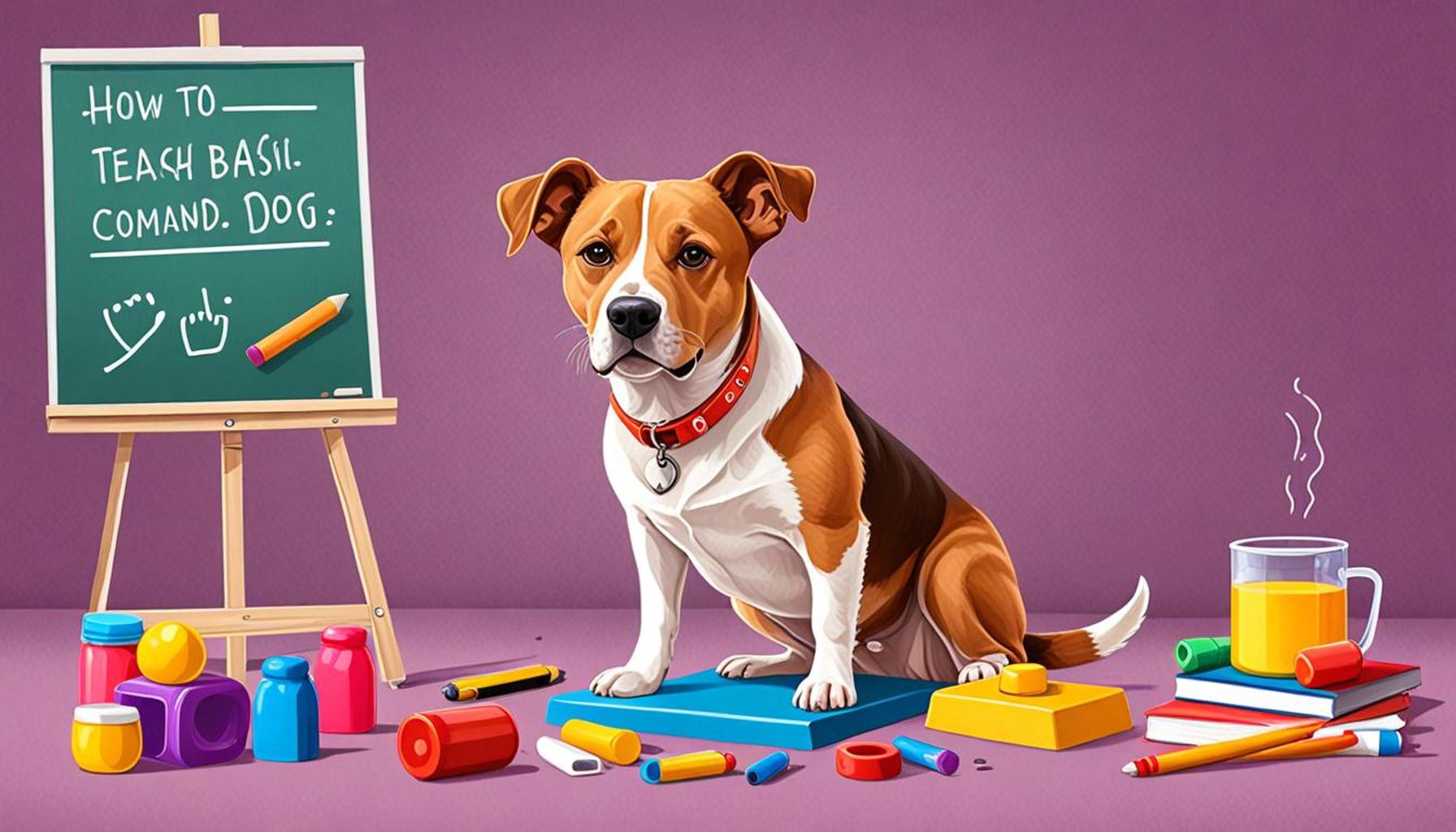Training Older Dogs: Tips for Adapting Techniques for Senior Pets

The Unique Needs of Senior Dogs
Training older dogs can be a rewarding yet challenging experience. As our furry friends age, they often develop specific needs and behavioral changes that require tailored approaches. This article explores effective strategies for adapting training techniques to accommodate the unique characteristics of senior pets.
Why Senior Dog Training is Important
- Mental Stimulation: Keeping your senior dog engaged is critical not only for their happiness but also for their cognitive health. Activities such as puzzle toys or gentle games of hide-and-seek can help prevent cognitive decline and keep their minds sharp.
- Behavior Modification: As dogs age, they may exhibit new or intensified behaviors, such as increased aggression or anxiety. Training provides an opportunity to address and modify these behaviors, ensuring a safer and more harmonious home environment.
- Strengthening Bonds: Training is not just about obedience; it’s a way to deepen the relationship between you and your dog, fostering trust and communication. When senior dogs feel secure and loved, they are likely to respond better to training efforts.
As many pet owners in the United States can attest, older dogs often have their own set of quirks, like a slower response time or decreased mobility. Understanding these changes is crucial for effective training. For instance, a dog that once easily jumped through hoops may now need encouragement to navigate stairs. By adapting techniques and incorporating gentler methods, you can help your senior pet thrive.
Key Considerations for Training
- Patience is Essential: Older dogs may take longer to learn new commands. It’s important to allow them ample time to process and respond without frustration. A slower pace can lead to more successful outcomes.
- Physical Limitations: Adjust training to accommodate mobility issues. For example, if your dog experiences joint pain, try training sessions on soft grass rather than harder surfaces, which can exacerbate discomfort.
- Positive Reinforcement: Reward-based training techniques work wonders for dogs of any age. Treats, praise, and gentle petting can motivate an older dog to learn new behaviors while ensuring they feel valued and loved.
By recognizing and embracing these considerations, pet owners can navigate the training process more effectively. Dive into this article to uncover expert tips and thoughtful techniques that ensure successful training for your beloved senior dog. From incorporating short training sessions to offer breaks in between, these methods not only respect your dog’s age but also contribute to their overall well-being and happiness.
It is crucial to remember that training older dogs is not just about commands but also about understanding their individual needs and quirks. Every small victory in training can lead to significant improvements in their quality of life, a testament to the enduring bond between a dog and their human companion.
DISCOVER MORE: Click here to learn about the emotional and social benefits of pet adoption

Understanding Behavioral Changes in Senior Dogs
As dogs age, their behavior and responses to training can change significantly, necessitating a thoughtful approach to their training regimen. Recognizing and understanding these shifts is crucial in creating a conducive learning environment for your senior dog. One of the most common changes is decreased energy levels. Older dogs may not have the same enthusiasm for play or exercise as they once did, which can affect their motivation during training sessions. Acknowledging this can help pet owners modify their expectations and take a more gradual approach to teaching new commands.
Common Behavioral Adaptations
- Increased Apathy: Senior dogs might show signs of disinterest in activities that previously excited them. This can lead to a lack of motivation during training sessions. To combat this, it’s important to incorporate rewards that particularly motivate your dog, whether it be treats, favorite toys, or extra affection.
- Potential Anxiety: Aging can increase a dog’s anxieties, making them more sensitive to their surroundings. Sudden noises or changes in routine may trigger stress responses. To ease discomfort, consider creating a calm training environment where distractions are minimized.
- Memory and Cognitive Changes: Just like humans, dogs can experience cognitive decline as they get older. This may manifest as forgetfulness or confusion during training tasks. Implementing short and simple training sessions can help reinforce their memory without overwhelming them.
Being aware of these behavioral adaptations allows dog owners to tailor their training strategies effectively. For example, implementing shorter training sessions can better suit their attention span, while offering frequent breaks can prevent them from feeling exhausted or frustrated. Additionally, using consistent cues and clear signals is essential for helping older dogs retain information.
Building a Supportive Training Environment
Creating a training environment that caters to the physical and emotional aspects of older dogs enhances their learning experience. Soft and comfortable areas to sit can minimize discomfort during training. Using positive reinforcement not only encourages learning but also helps build their confidence. A quick game after a successful training session can solidify the joy associated with learning new commands.
Understanding and adapting to the behavioral changes that come with aging can improve your senior dog’s learning experience significantly. By establishing a supportive and patient approach, you create an atmosphere that fosters trust, which is imperative for a successful training journey. Remember, each small step taken in training is a building block towards a happier and healthier life for your furry companion.
| Category | Details |
|---|---|
| Patience in Training | Older dogs may take longer to learn. Consistency and patience are essential when adapting training techniques. |
| Positive Reinforcement | Reward-based training can motivate older dogs, enhancing their mental stimulation and fostering a positive learning environment. |
| Physical Limitations | Senior dogs often experience limitations due to age. Adapt training techniques to accommodate these challenges, focusing on short and gentle sessions. |
| Mental Engagement | Older dogs thrive on mental exercises. Incorporating puzzle toys and slow-paced training can keep their brain active and engaged. |
When retraining older dogs, it’s crucial to consider their overall health and adaptability. For instance, regular vet check-ups can ensure that your pet’s special needs are addressed during training sessions. Moreover, incorporating elements like gentle obedience commands can significantly improve their responsiveness without causing undue stress or fatigue. Whether it’s basic commands or fun tricks, keeping training light-hearted and enjoyable can ultimately strengthen the bond between you and your senior pet. Adjust expectations and embrace small victories; they are cherished moments for both owners and their canine companions.
DISCOVER MORE: Click here to learn effective strategies
Adapting Training Methods for Senior Dogs
When it comes to training older dogs, adjusting traditional methods is essential to cater to their specific needs. As their physical capabilities and cognitive functions decline, modifications to techniques can make a significant difference in the effectiveness of training sessions. One practical approach is to focus on gentle, consistent reinforcement that emphasizes patience and understanding.
Incorporating Life Skills Training
Rather than solely aiming to teach new tricks or commands, consider incorporating life skills training into your senior dog’s routine. This includes reinforcing positive behaviors such as house training, basic commands, and beneficial routines like sitting calmly for grooming. Life skills not only keep your dog mentally stimulated but also enhance their ability to navigate their environment safely.
Additionally, implementing adaptive training techniques can be beneficial. For example, introducing clicker training or using visual cues alongside verbal commands can provide extra help for dogs experiencing cognitive decline. This technique capitalizes on their natural learning abilities while minimizing confusion, allowing for a more engaging and rewarding experience.
The Role of Routine
Establishing a training routine is critical for senior dogs. Regular training sessions at the same time each day can help your pet feel more secure and create a structured environment where they understand what to expect. This consistency promotes memory retention and helps reinforce the commands being taught. It’s advisable to limit these sessions to 5-10 minutes, depending on your dog’s stamina, and always end on a positive note with praise and affection.
Utilizing Health Considerations
Health conditions common in older dogs, such as arthritis or impaired vision, also necessitate adaptations in training techniques. When teaching commands, it’s vital to ensure that movements are comfortable for them. For example, instead of using standing commands, consider rewarding your dog for sitting or lying down. This approach not only accommodates physical limitations but also reinforces a relaxed state during training.
Furthermore, engaging in simple activities such as sniff and search games can harness their sense of smell while providing low-impact exercise. This method not only keeps training enjoyable but also aligns with their natural instincts, making the learning process more instinctual and fulfilling.
Consulting Professionals
Sometimes, working with a professional dog trainer or a behaviorist who has experience training senior dogs can yield excellent results. These experts can provide personalized guidance tailored to your dog’s specific needs, enhancing both training efficacy and the bond between you and your pet. Additionally, they can help identify any potential health concerns that could influence training performance.
Training older dogs comes with unique challenges, but by adapting techniques with compassion, patience, and creativity, pet owners can pave the way for a more enriched life for their senior companions. Exploring various methods and understanding your dog’s individual needs can ensure that training remains a positive experience. Remember that each success, no matter how small, contributes to a fulfilling partnership with your cherished furry friend.
DISCOVER MORE: Click here to learn effective training techniques
Conclusion
In conclusion, training older dogs requires a thoughtful and adaptable approach to meet the unique needs of our senior companions. As their bodies and minds change, it becomes essential to tailor training methods that foster a sense of understanding and connection. Emphasizing gentle, consistent reinforcement, integrating life skills training, and establishing a routinized schedule can greatly enhance the training experience for both pets and owners.
Moreover, being mindful of health considerations, such as mobility issues and cognitive decline, allows for the implementation of techniques that respect your dog’s physical comfort. Engaging your senior dog with enjoyable and low-impact activities, like sniff and search games, not only keeps them active but also satisfies their innate instincts, making each training session an enriching experience.
Finally, consulting with a professional who specializes in training senior dogs can provide valuable insights and tailored strategies. These experts can help uncover possible health concerns impacting your dog’s learning, ensuring a safe and effective training environment.
Ultimately, the journey of training an older dog is not just about commands and tricks; it’s about nurturing a thriving relationship built on respect, patience, and love. By adapting your techniques and understanding your dog’s individual needs, you can cultivate a rewarding training experience that continues to strengthen the bond you share with your beloved pet in their golden years.


